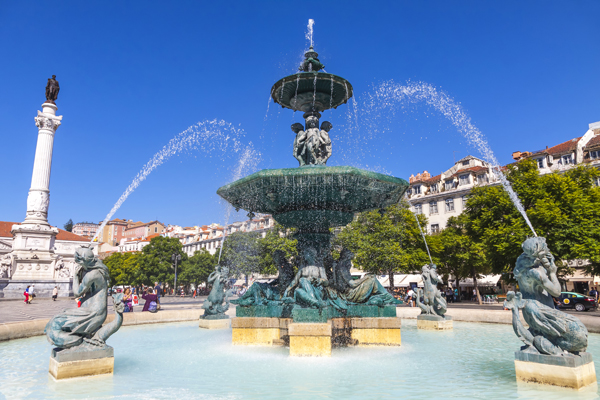Best Neighborhoods for Retirees in Lisbon
Summary: If you''re retiring in Lisbon, here are some of the best neighborhoods in Lisbon for retirees.

Lisbon, the sun-kissed capital of Portugal, is a city that combines old-world charm with the vibrancy of modern urban life. It's no wonder that it has become a favored destination for retirees from around the globe. With its mild climate, rich culture, and affordable cost of living, Lisbon offers a variety of neighborhoods that cater to the diverse preferences of expats and retirees. From tranquil, historic areas to bustling, scenic locales, here are some of the best neighborhoods in Lisbon for retirees to call home.
Alfama
Alfama, one of Lisbon's oldest districts, is a labyrinth of narrow streets, traditional Fado music houses, and stunning viewpoints. Retirees are drawn to Alfama for its sense of history and community. The area is relatively peaceful, yet it brims with cultural activities. Residents can enjoy leisurely walks through its cobblestone streets, visit the Sao Jorge Castle, or relax in one of the many quaint cafes. The Feira da Ladra, a flea market held twice a week, is a local favorite for finding unique treasures.
Location: Central Lisbon, nestled between the Sao Jorge Castle and the Tagus River.
Real Estate: Alfama offers a mix of traditional apartments and renovated properties. Prices can vary widely depending on the state of the property.
Healthcare: There are several clinics and pharmacies in the area, with larger hospitals easily accessible by public transport.
Where to Eat: Alfama is renowned for its Fado restaurants, such as A Baiuca and Clube de Fado, where one can enjoy traditional Portuguese cuisine accompanied by live music.
Interesting History: Alfama was one of the few districts to survive the great earthquake of 1755, preserving its medieval charm.
Volunteer Organizations: Various cultural associations in Alfama welcome retirees looking to engage with the community.
Parks: The Miradouro de Santa Luzia offers stunning views and a serene garden for relaxation.
Estrela
Estrela is known for its lush gardens, baroque Basilica da Estrela, and the historic tram 28 that meanders through the neighborhood. It's a favorite among retirees who seek a quieter lifestyle but still want to be close to the city center. The Jardim da Estrela, a picturesque park, is perfect for afternoon strolls or picnics. The neighborhood also has a friendly expat community, making it easier for newcomers to settle in and make friends.
Location: West of Lisbon's city center, bordered by the Santos and Campo de Ourique districts.
Real Estate: Estrela features a range of properties, from luxury apartments to more affordable options.
Healthcare: The neighborhood has several high-quality health clinics and is close to some of Lisbon's best hospitals.
Where to Eat: Estrela has a variety of restaurants, including the well-regarded Clube dos Jornalistas and Tasca da Esquina.
Interesting History: The Basilica da Estrela, with its striking dome, was built in the late 18th century by order of Queen Maria I.
Volunteer Organizations: Retirees can contribute to local charities and community centers that often organize events.
Parks: The Jardim da Estrela is the neighborhood's centerpiece, offering a peaceful retreat with exotic plants and a small lake.
Lapa
Lapa is an upscale residential area known for its elegant mansions, embassies, and a tranquil atmosphere. It's a prestigious address in Lisbon, offering retirees a luxurious lifestyle. The neighborhood is home to the Museu Nacional de Arte Antiga, which showcases a vast collection of European and Asian art. Lapa's serene streets are ideal for leisurely walks, and its proximity to the riverfront provides beautiful sunset views.
Location: West of the city center, stretching from Santos to Estrela.
Real Estate: Lapa is one of the more expensive areas in Lisbon, with real estate prices reflecting its high-end status.
Healthcare: The area is well-served by private clinics and is close to several reputable hospitals.
Where to Eat: Lapa boasts fine dining establishments such as Come Prima and O Nobre.
Interesting History: The neighborhood has a rich diplomatic history, with many foreign embassies located here.
Volunteer Organizations: Community-focused groups in Lapa offer opportunities for retirees to get involved with local initiatives.
Parks: Although Lapa is more urban, nearby Jardim da Estrela provides ample green space.
Principe Real
Principe Real is a trendy and vibrant neighborhood that appeals to retirees who enjoy a cosmopolitan lifestyle. Known for its 19th-century mansions, boutique shops, and organic markets, Principe Real is both charming and lively. The Jardim do Principe Real is a popular spot for relaxation and hosts a weekly organic market. The area is also home to numerous art galleries and design shops, perfect for those with a creative streak.
Location: North of Bairro Alto, known for its bohemian vibe.
Real Estate: The neighborhood offers a mix of historic homes and modern apartments, with prices varying widely.
Healthcare: There are several pharmacies and health centers in Principe Real, with hospitals easily accessible in nearby areas.
Where to Eat: The neighborhood is filled with trendy eateries, such as A Cevicheria and Atalho Real.
Interesting History: Principe Real was named after Queen Maria II's firstborn son and has been a fashionable district since the 19th century.
Volunteer Organizations: Cultural associations and environmental groups are active in the area, offering retirees a chance to give back.
Parks: The Jardim do Principe Real is a beautiful park with exotic trees and a large greenhouse.
Avenidas Novas
Avenidas Novas offers a blend of modern comforts and leisurely living, making it an attractive neighborhood for retirees. With wide avenues lined with shops, cafes, and restaurants, it's a convenient and accessible area. The Gulbenkian Museum and its surrounding gardens provide a cultural hub with art collections, concerts, and workshops. Avenidas Novas is also known for its excellent public transport connections, making it easy to explore the rest of the city.
Location: North-central Lisbon, extending from Marques de Pombal Square to beyond Campo Pequeno.
Real Estate: The area features modern apartment buildings with a range of prices to suit different budgets.
Healthcare: Avenidas Novas has numerous healthcare facilities, including the large Hospital de Santa Maria.
Where to Eat: The neighborhood is home to diverse dining options, from traditional Portuguese to international cuisine.
Interesting History: The area developed during the 20th century, reflecting the expansion and modernization of Lisbon.
Volunteer Organizations: There are community centers and social support institutions where retirees can volunteer.
Parks: The gardens of the Gulbenkian Museum offer a tranquil oasis in the heart of the city.
Belem
Belem is a historic district located to the west of Lisbon's city center, known for its monumental architecture and cultural landmarks. Retirees who are history enthusiasts will appreciate living amongst iconic sites like the Jeronimos Monastery and the Belem Tower. The neighborhood is also famous for its pastries, particularly the Pasteis de Belem. With its riverside location, Belem offers retirees scenic walks along the Tagus River and a laid-back atmosphere.
Location: Situated along the Tagus River, west of Lisbon's city center.
Real Estate: Belem has a mix of historic buildings and newer developments, with prices generally higher due to its tourist appeal.
Healthcare: There are several healthcare providers in the area, and the proximity to major hospitals is a plus.
Where to Eat: Belem is a culinary delight, with options ranging from the historic Pasteis de Belem to modern waterfront dining at Darwin's Cafe.
Interesting History: Belem is steeped in maritime history and was the departure point for many of Portugal's explorers.
Volunteer Organizations: Cultural institutions in Belem often seek volunteers for various events and activities.
Parks: The expansive Jardim Botanico Tropical and the Belem Cultural Center provide green spaces and cultural events.
Campo de Ourique
Campo de Ourique is a residential neighborhood that exudes a village-like charm, making it perfect for retirees seeking a sense of community. The area is known for its local market, Mercado de Campo de Ourique, where residents can shop for fresh produce and enjoy a variety of food stalls. The neighborhood has a slower pace of life, with tree-lined streets and small parks, yet it's still well-connected to the rest of Lisbon.
Location: Located between Estrela and Amoreiras, in the western part of Lisbon.
Real Estate: Campo de Ourique offers a range of housing options, from traditional apartments to modernized units, at reasonable prices.
Healthcare: The neighborhood has a good selection of clinics and is close to larger medical facilities.
Where to Eat: The Mercado de Campo de Ourique is a foodie's paradise, and local restaurants like Coelho da Rocha offer traditional Portuguese dishes.
Interesting History: Campo de Ourique has a literary history, with famous Portuguese writer Fernando Pessoa having lived in the area.
Volunteer Organizations: There are local associations focused on social welfare and cultural promotion where retirees can get involved.
Parks: Jardim da Parada is a popular local park for relaxation and community events.
Graça
Graça is a picturesque neighborhood that sits atop one of Lisbon's highest hills, offering retirees breathtaking views of the city. It's a tranquil area with a mix of traditional and bohemian vibes. The Miradouro da Graça and Miradouro da Senhora do Monte are popular spots for taking in the panoramic views. Graça's narrow streets are dotted with artisan shops, cafes, and historic buildings, providing a charming setting for a leisurely retirement.
Location: Perched above the Alfama district, to the east of the city center.
Real Estate: Graça has a variety of housing options, with prices generally lower than in more central areas.
Healthcare: The neighborhood has several pharmacies and local health services, with hospitals easily reachable by public transport.
Where to Eat: Graça offers a range of dining experiences, from traditional Portuguese at Via Graça to international cuisine at Bistro Gato Pardo.
Interesting History: The area is home to the 17th-century Igreja da Graça, one of the city's oldest churches.
Volunteer Organizations: Community projects and cultural associations in Graça welcome the participation of retirees.
Parks: The neighborhood's miradouros serve as communal gathering spaces and offer some of the best views in Lisbon.
Each of these neighborhoods in Lisbon offers its unique charm and amenities, making them ideal for retirees looking to enjoy their golden years in this vibrant city. With a range of cultural attractions, parks, and community activities, there's a perfect Lisbon locale for every retiree's taste and lifestyle.
About the Author
 Joshua Wood, LPC joined Expat Exchange in 2000 and serves as one of its Co-Presidents. He is also one of the Founders of Digital Nomad Exchange. Prior to Expat Exchange, Joshua worked for NBC Cable (MSNBC and CNBC
Primetime). Joshua has a BA from Syracuse and a Master's in Clinical and Counseling Psychology from Fairleigh Dickinson University. Mr. Wood is also a licensed counselor and psychotherapist.
Joshua Wood, LPC joined Expat Exchange in 2000 and serves as one of its Co-Presidents. He is also one of the Founders of Digital Nomad Exchange. Prior to Expat Exchange, Joshua worked for NBC Cable (MSNBC and CNBC
Primetime). Joshua has a BA from Syracuse and a Master's in Clinical and Counseling Psychology from Fairleigh Dickinson University. Mr. Wood is also a licensed counselor and psychotherapist.
Some of Joshua's articles include Pros and Cons of Living in Portugal, 10 Best Places to Live in Ireland and Pros and Cons of Living in Uruguay. Connect with Joshua on LinkedIn.
First Published: Jul 07, 2024


